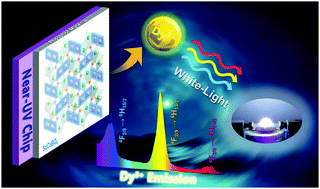The radius of trivalent scandium ions is much smaller than those of other rare earth ions and thus research studies targeting the substitution of the scandium site with other light-emitting rare earth ions are rarely reported. In our present work, special attention is paid to the effect of Dy3+ doping on the crystal structure, atomic site occupancy and luminescence properties of the ScCaBO4 host as Dy3+ often serves as an individual activator for single-phase white light-emitting phosphors. Herein a series of ScCaBO4:Dy3+ phosphors were prepared by solid-state reactions. The phase composition was recorded by X-ray diffraction analysis and XRD refinement reveals that a pure phase could be maintained even when the Dy3+ concentration reaches 11%. Scanning electron microscopy (SEM) was utilized to observe the morphology and EDS mapping was used to investigate elemental distribution. The luminescence performances of the phosphors were investigated using UV-vis diffuse reflectance spectra, steady-state excitation and emission spectra and also transient luminescence decays. Dy3+ luminescence can be ascribed to its 4F9/2 → 6H15/2, 6H13/2 and 6H11/2 transitions, producing blue, yellow and red emissions. The Dy3+ concentration was further optimized at 3%, at which the CIE coordinates and fluorescence lifetimes were (0.425, 0.413) and 0.546 ms, respectively. Thermal quenching studies of the ScCaBO4:0.03Dy3+ phosphor show that Dy3+ luminescence at 400 K can maintain 60.91% of its initial value measured at room temperature. All the results indicate that the ScCaBO4:Dy3+ inorganic phosphors could be a promising single component phosphor for near-UV chip based WLEDs.

